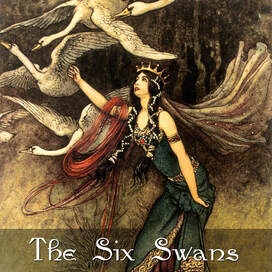In literature the world over the child is a symbol of divinity. The child mirrors the inner reality of the soul & reflects the wishes, hopes & longings to which we aspire. Thus the child becomes a symbol for that which is new and yet to come.
Extracts from The Archetype of the Child - Jung Socirty of Atlanta published 27h Sept 2014

There are so many children in such tales - banished from the warmth and protection of home - sent away into the forest in the hope they might be lost or devoured by wild animals.
Why is this such a powerful and recurring motif? What light might it shed on our current situation? And What lessons can we learn ?
I wonder which fairy-tale comes to your mind when we speak of such banishments? It’s an interesting question - more than we may first imagine - for the tales we resonate most strongly with are those that tell us most about ourselves and possibly our own deep woundings.
So let’s see shall we - let’s see what is to be seen.

All featuring some kind of Wicked Stepmother figure - the real mothers of so many of these children having died - leaving their children at the mercy of an often pathetic father and new wife who cannot find it in her heart to love his children even whilst knowing that this would surely be the very best way to his heart. But somehow the necessary warm cannot be accessed. Then there are those parents - like the ones of Red Riding Hood, who simply do not think things through when sending her off into the forest - or those who frankly fail in their responsibilities - like Hansel & Gretal's odd family.
Female children, princesses in many cases often unwittingly stir up huge insecurity and jealousy in the new wife - whose own beauty seems to fade in direct relationship to the growth of the child’s. It is often then that she makes her move - as in the tale of Snow White.
The motif recurs in Vassilisa’s story - but here it’s not just the stepmother but the ugly sisters too who feel threatened - so off they send her - into the deep, dark wood - in the hope she will never ever return.

He desperately tries to hide his children when he realises the new queen's intent - but of course she finds them - as she does in the Irish tale and casts her evil spell anyway. The children are utterly overtaken by the charm she has worked and are instantly transformed into six white swans.
The Queen laughs mercilessly when she sees her magic working and flings her arms into air triumphantly.
“Take to the skies in swans white down, she cries
No more shall you wear your human crown.
‘'Tis I alone share your father’s throne,
Whilst you poor creatures the wild world roam.
Though never more you shall belong
You’ll haunt men’s hearts with sweet swan song.”
The Six Swans: Adapted by Anne Maria Clarke
And by far one of the greatest qualities represented is Innocence - so pure and untainted, open-hearted & kind. Beautiful by name & Beautiful by nature - and yet without thought or care for outward things.
In myth they are Divine Children, as said above - yet even here - in this more humble setting - such children - though they must all grow up and evolve their innocence into experience, as the poet Blake tells - their state at the moments of their banishment & neglect is hugely significant.
For if - as Ann Baring suggests - the Fairytale Court or Family represents the whole - inner & outer - personal & collective - then how will we possibly fare - split off from all that they are?????
Winncott called the motif of the child - the true self - others the lost heart of the self. The life giver - or core of innocence which is the crucial element in a persons spiritual nature.
Extracts from The Archetype of the Child - Jung Society of Atlanta published 27h Sept 2014
Anne Maria
x x x






